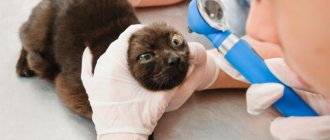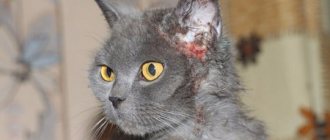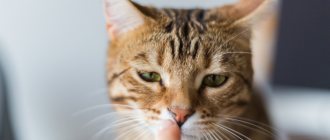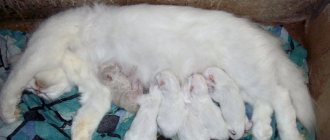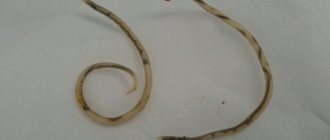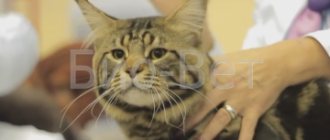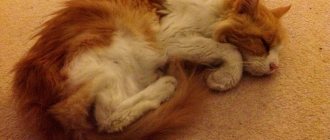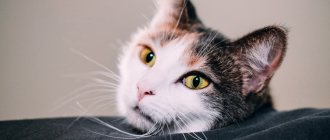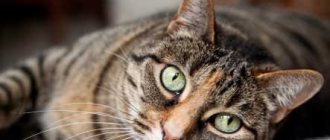Every “cat breeder” with more or less experience knows that these animals are rare clean animals. Therefore, if any suspicious spots appear on a cat’s fur, crusts stick to it and the general “negligence” of the pet’s appearance, it is necessary to seriously concern itself with the state of his health. The fact is that such symptoms often occur with weeping dermatitis in cats.
General information, predisposing factors
This is the name of a skin disease of inflammatory etiology, which is accompanied by a rash, peeling of the skin, as well as the release of ichor and exudate (especially in places of folds) . The area of the muzzle, ears, neck, interdigital spaces, and, less commonly, other areas of the skin are severely affected. Veterinary statistics indicate that the disease is more common among kittens under one year of age, but (in much rarer cases) it also occurs in adult cats.
What are the causes of the disease? Such dermatitis is not contagious (however, it all depends on the root cause), it can be transmitted genetically, occur due to disruption of the digestive system (for example, intestinal dysbiosis), as well as due to contact of the skin and external irritants (household chemicals, pollen, paint products, etc.). Dermatitis is widespread in areas with high levels of environmental pollution. In particular, it is much more common in cats living in houses directly adjacent to streets with heavy traffic.
Cats can regulate their own body temperature
When the apartment is very hot, it is impossible to see a cat on the back of the sofa or even higher, on the closet. At this time, cats like to stretch out on the floor in the room or will even ask to go to the bathroom, since it is noticeably cooler there, they do not sweat, but they are comfortable. You can guess that pets are trying to fight a high temperature if :
- They often lick their fur. Copious saliva hits the skin and cools it.
- They sleep more time and do not make unnecessary movements. They stop playing and frolicking.
- Start drinking a lot of water.
- When cats are close to heatstroke, they open their mouths and breathe heavily.
The normal temperature of cats is slightly higher than that of humans, so you should not leave cats in a closed car, even for a short time. The temperature inside can rise very quickly, and they will die from heatstroke, since they sweat very little. Sometimes cats open their mouths while in a car. In this case, they may not have enough oxygen or they feel an unpleasant odor that literally “hits” their nose. We urgently need to open the window slightly and the animals themselves will choose the best place for themselves. For an air conditioner, it is important to choose a mode that is acceptable for animals.
© shutterstock
Cats sweat or overheat not only from high temperatures, but also from physical activity. They begin to lick themselves not in order to put the fur that flutters in place as they move, but for the sake of cooling.
Despite extremely low sweating, cats still like to warm up. If you stroke a pet lying in the yard in a sunny place, you may be surprised at how hot its fur is. However, the animal feels great, does not sweat, and some object suitable for hunting will make it instantly concentrate. Fresh air and even a light breeze allow your pet not to suffer from overheating. But at the same time, cats can happily walk on the hot iron on the roof at noon.
Clinical picture
This disease is characterized by a relapsing course with exacerbations that occur more often in the warm season (more microorganisms). The main signs are: severe itching, which is why a sick cat can scratch the skin vigorously, sometimes until it bleeds; rashes on the affected skin, peeling, flaking; dry skin all over the body. Blisters and papules gradually form on the skin. They open, resulting in a large amount of ichor flowing onto the skin. Being contaminated with pathogenic and conditionally pathogenic microflora, the exudate begins to decompose and smell bad. All this not only causes your pet severe pain, but can also cause the development of septic phenomena.
Reasons for deviations
Deviations may occur in the direction of dryness or increased humidity of the nose, both of which can be warning signs of complications.
Excessive nasal dryness may indicate:
- lack of fluid in the body;
- respiratory tract infections;
- diseases of internal organs and inflammation;
- together with elevated ear temperature can cause ear mites.
Excessive fluid discharge may be a consequence of such common diseases;
- inflammation of the gums and teeth;
- chronic rhinusitis;
- the formation of polyps on the mucous membrane, usually with characteristic difficulty breathing;
- hypothermia of the body;
- allergic reactions;
- chemical poisoning.
Strong odors that are not so noticeable to humans, such as ammonia, cigarette smoke, and disinfectants, can irritate the mucous membrane, causing excessive moisture release.
Diagnostic techniques
Diagnosis is made through visual examination of the skin. The specialist must understand at what stage the development of the disease is, and also make an assumption about what exactly could have caused its appearance. The owner must give the specialist as complete information as possible about when and after what something wrong happens to the pet.
Monitoring symptoms (itching, rashes, peeling, frequency of new blisters) is of important diagnostic importance But identifying external signs of the disease is only half the battle. First, the doctor (if possible) must determine whether the pathology has occurred in your pet’s closest relatives. Secondly, and even more important, it is necessary to establish whether pathogenic and conditionally pathogenic microflora (and this almost always happens), and also to identify its exact type. The diagnosis is made, as a rule, in the presence of three or more symptoms characteristic of atopic dermatitis.
general information
A cat's nose consists of two nasal canals separated by cartilage. The drawn air enters the nasal chambers, from which it enters the winding channels. In these channels, the smell is purified from foreign impurities, which allows the cat to recognize the nature of the smell.
cat nose
Special cells associated with the olfactory region of the brain are responsible for recognizing odors. The nasal sinuses perform not only the function of smell, but also thermoregulatory and filtering. The air drawn in has time to heat up to the required temperature and be cleaned of the smallest molecules of dust and bacteria.
The area accessible to human touch that is mistaken for the animal's nose is actually the skin around the nostrils and is called the lobe. It is by this that the owner judges the health status of the pet. A healthy cat's nose should be moist, cool and rough. But not noticeably wet and cold.
Why is my nose cool?
One of the main functions of the nasal lobe is the animal's thermoregulation. The lack of sweat glands in a cat's body means that cooling of the body in hot conditions occurs through the nasal cavity and open mouth, so the nose is cool.
Thermoregulation through the nose and open mouth
Deviation from the norm indicates possible pathological processes in the cat’s body, for example, a warm nose lobe indicates an increase in body temperature and a possible fight of the immune system against viruses or bacteria.
Why does a cat have a wet nose?
A moistened surface makes it easier for a cat to catch and recognize odors around; other animals, such as dogs, also have a similar feature.
Wet nose close up
Diagnosis of the problem and difference from similar skin diseases
Before you understand exactly how to treat eczema in a cat, you need to establish its cause. Do not treat the affected area with medications before going to the veterinary clinic - using ointments and sprays without prescription will either blur the symptoms and complicate the doctor’s work, or will aggravate the existing problem.
The symptoms of the pathology are similar to ringworm and demodicosis, which require completely different treatment. In the first case, deformation of the claws occurs, in the second, scabs appear in the lesions, protecting the wounds from secondary infections. In both pathologies, hair falls out slowly, and the affected area quickly increases.
For eczematous lesions, the situation is the opposite: rapid baldness and slow growth of erosion. Remember that shingles is transmitted to humans, and try to avoid close contact until a diagnosis is made.
The main diagnostic methods include blood tests, skin scrapings and ultrasound. These studies help to identify deviations in basic indicators, assess the condition of internal organs, and determine the causative agent of infection or other provoking factors. The presence of helminthiasis is confirmed or refuted using stool and urine tests.
Treatment methods
For a successful and rapid recovery of your pet, you must strictly follow all medical recommendations without deviating from the treatment regimen. In some situations, taking medications can last for almost a month, despite the disappearance of symptoms. This duration is explained by the need to eliminate all internal violations that can only be monitored using equipment.
Medicines prescribed by a veterinarian
First of all, the main cause of the ailment is eliminated: the material of the collar is changed, allergenic foods are removed from the diet and the diseases found are treated. In case of severe intoxication, the animal is given cleansing drips with saline and glucose: they help normalize the water-salt balance and improve overall well-being.
Most often, a sick animal is treated with the following drugs:
- antibiotics (Amoxicillin, Erythromycin, Sinulox) that fight the infectious agent;
- antihistamines (Suprastin, Cetrin, Diphenhydramine) and glucocorticosteroids (Prednisolone, Dexamethasone), which suppress the body’s excessive sensitivity;
- anthelmintics (Milbemax, Drontal, Profender), destroying adult parasites and their larvae;
- hepatoprotectors (Hepatovet, Covertal, Hepatoject), restoring liver functionality;
- sedatives (Stop-stress, Cat Bayun), preventing exacerbation of neuropathic diseases;
- diuretics (Furosemide, Hypothiazide), facilitating the removal of toxins;
- immunomodulators (Gamavit, Catozal, Vitam), stimulating the work of immune cells.
To treat weeping eczema in cats, antiseptics (miramistin, chlorhexidine) and antimicrobial agents are used, which have a healing effect and effectively dry out wounds. The dry appearance, on the contrary, is moistened using naphthalan ointment and Vishnevsky liniment.
Acceptable use of folk remedies
At home, treatment for eczema in cats may include folk remedies. These include:
- aloe juice, which improves tissue regeneration;
- infusion of currant leaves, which improves immunity;
- sea buckthorn and St. John's wort oil, which relieves pain and inflammation;
- a decoction of oak bark and chamomile, which eliminates irritation and protects against germs;
- an infusion of burdock and dandelions, which normalizes metabolism and has a diuretic effect;
- a compress of celery and sunflower oil, recommended for eliminating dry inflammation.
All of the listed remedies are used as part of complex therapy and do not exclude taking medications from the pharmacy. Before using them, be sure to make sure there is no allergic reaction by dropping a small amount of infusion or ointment on the skin.
Remember that some traditional medicine recipes can be deadly. These products include birch tar and other tar-containing preparations. They are poisonous to the feline family, so be sure to consult your veterinarian about acceptable prescriptions during diagnosis.
Hygiene and maintenance of a sick pet
The hair on the affected areas must be cut or shaved, treating the skin with a neutral antiseptic. To avoid enlargement of pathological lesions, your pet should be wearing a protective collar - it will prevent scratching of wounds and licking of healing ointments.
Carry out wet cleaning daily in the room where the sick animal is located. Pay special attention to his sleeping place and feeding troughs.
Be sure to make sure there are no drafts. Remember that during treatment the immune system is very weak and vulnerable to colds and infections. If the cat is used to walking outside, put him in quarantine until he recovers.
Try to minimize stress by keeping your pet away from noisy children and overly active pets. Remember to give sedatives as prescribed by your veterinarian.
Review your diet by eliminating the most common allergens: fish, eggs, chicken, wheat and other grains. When dry feeding, it is recommended to switch to hypoallergenic food. If your pet is accustomed to natural products, be sure to add vitamins prescribed by your doctor to his food.
Reverse cat
A thunderstorm, more like a storm among the high-rise buildings. Water from puddles, and she was thoroughly wet. And somewhere Armstrong is pouring out of the speakers. And the downpour knocks in rhythm on the foggy windows. Again a Chinese umbrella imitating a bird. He flew, taking a course similar to his native China. Leaving broken knitting needles in my hand as a farewell. Laughter, I leaned towards the asphalt, Chinese tea was waiting at home. A pensioner wanted to give her a seat on the bus. Probably for the pitiful appearance of a thoroughly wet cat. From the stop, another five minutes, through the old square. Green boots stomped on wet leaves. Here is the native entrance, the door blocks the way. And the fingers hastily enter the code. Suddenly, out of nowhere, a beast appeared. More precisely, an arrogant, wet black cat. -: What do you want, my dear? Smiling and continues: Yes, I know it’s a thunderstorm. And the cat stands motionless. He just bulged his green eyes even more. She giggled and walked hurriedly towards the stairs. Deciding that the cat really wasn’t too talkative. The cat doesn’t give a damn, he is tightly glued to her. She goes home, and he goes home, so important, silently... So homely, robe, slippers. Oolong for yourself, and a bowl of milk for the beast. Under the raucous jazz, in the light of a dim light bulb, I fell asleep. Outside the window, thunderclouds were diligently sobbing... That night she dreamed of unrealistically passionate sex. And awakening became a terrible torment. She stretched and called the cat, but the cat disappeared. -:Kitty Kitty. Well, where are you, fool? Meow? She opened her eyes, God, how rumpled the bed was! It was as if a herd of horses was grazing in it at night. There was an ashtray with cigarette butts and chewed mint in it. And the milk is there, but for some reason the oolong ran out...
Wet cat pictures
Varieties according to flow form
Another classification is based on the form of the course, that is, the speed of development and severity of symptoms. The most favorable prognosis is typical for the acute form.
Acute
The acute course is characterized by the sudden appearance and rapid increase of all of the listed symptoms. Kittens often suffer from this form.
Despite their weak immunity, they recover quite quickly soon after starting drug therapy. This is explained by the timely detection of the disease and the small number of pathological changes inside the body.
Subacute
The subacute form develops after 1-1.5 months as a complication of the acute form. It is difficult to treat and often becomes chronic.
Chronic
Unlike acute and subacute, the chronic form is rarely accompanied by wet ulcers. It is characterized by constant peeling and partial baldness. Chronic pathology often occurs in older cats and pets weakened by concomitant diseases.
This disease is practically incurable and can last for years, accompanied by a series of remissions and relapses. To improve the condition of a sick animal, maintenance therapy is used.
Nose care
The olfactory organ plays an important role in the life of a healthy cat. It requires the attention of not only the animal, but also the owner, who helps maintain hygiene and quickly respond to changes in the condition of the nose. It is necessary to regularly monitor the frequency and duration of periods of dry nose, not forgetting other factors that indicate the possibility of the disease.
You can clean your cat’s nose with a cotton pad or a swab dipped in cool, boiled water, penetrating further than the nostrils to prevent injury to the fragile organ. Do not use products containing alcohol or fragrances. After the procedure, you should remove any excess moisture from your nose.
It is necessary to help the cat keep its nose clean, otherwise breathing will be complicated, the work of secretions secreting liquid will be disrupted, and as a result, the mirror of the nose, rightly called the mirror of the cat’s health, will heat up due to impaired thermoregulation.
Dangerous symptoms
You can determine the line between a healthy raw nose and a condition caused by a disease using approximate symptoms.
In case of decreased activity and refusal to eat, accompanied by hair loss with a cold and dry nose, an imbalance in the food consumed is possible. Then, under the guidance of a veterinarian, you need to find out what the body is missing and adjust the diet.
Unusual paleness of the nose may be the result of anemia or other abnormalities in the functioning of the circulatory system. A bluish tint to the nose in most cases indicates heart disease. In this case, the nose may remain cold.
If a clear, thin liquid is flowing from your cat's nose, insects, such as fleas or small midges, may have entered the respiratory tract. This also happens with poisoning, fungal diseases, or in the case of abnormal congenital structure of the nose.
Among your cat's personal belongings, there should be a thermometer.
A clear fluid may be released when you have a cold caused by infection or hypothermia. Treatment prescribed by a doctor will solve this problem. Along with taking medications, the owner will have to rinse the cat's nose and instill prescribed drops.
Blood may be present in nasal discharge, which may indicate head or nasal injury, nasal infections, or tumors. Blood is also released through the respiratory organ in chronically high blood pressure.
These general characteristics can help determine the cause of nasal discharge. But if your cat shows signs of feeling unwell, but none of these symptoms are appropriate, you should contact a specialist to rule out a possible health threat.
